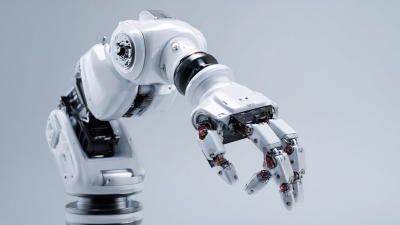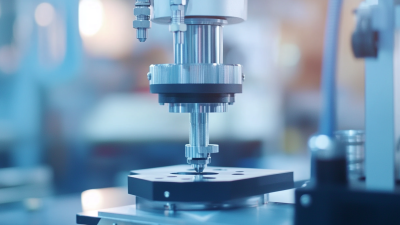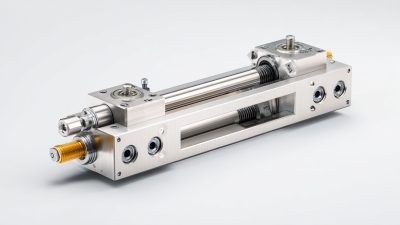 sales@loadcellsensor.com
sales@loadcellsensor.com

Unlocking Precision: The Future of 3-Axis Force Sensors in 2025's Top Innovations
As industries continue to evolve in the wake of advanced technologies, the demand for precision measurement tools has never been greater. Among these, the 3-Axis Force Sensor stands out as a pivotal innovation poised to revolutionize various sectors, including robotics, automotive, and healthcare. According to a recent market research report by MarketsandMarkets, the global force sensor market is projected to reach $6.77 billion by 2025, with a significant portion attributed to the increasing adoption of 3D sensing technologies. This growth is driven by the need for accurate force measurement in applications such as robotic manipulation and quality assurance processes.

Moreover, with the proliferation of smart manufacturing and Industry 4.0, the role of 3-Axis Force Sensors is becoming increasingly critical. By enabling real-time feedback and enhanced precision in force application, these sensors facilitate improved automation and contribute to overall operational efficiency. According to a report from Research and Markets, the implementation of advanced sensor technologies—including 3-Axis Force Sensors—could reduce production costs by up to 30% while enhancing product quality and consistency. As we look towards 2025, it becomes evident that the integration of 3-Axis Force Sensors will not only drive innovation but will also set new standards for performance across multiple industries.
Exploring the Evolution of 3-Axis Force Sensor Technology for 2025 Applications
As we look toward 2025, the evolution of 3-axis force sensor technology is redefining various applications across industries such as robotics, healthcare, and consumer electronics. According to a report by MarketsandMarkets, the global market for force sensors is projected to reach USD 1.5 billion by 2025, driven by the increasing demand for precision measurement in critical applications. These sensors, capable of measuring force along three perpendicular axes, enable accurate feedback and control, enhancing the performance of automated systems.
One notable advancement is the integration of artificial intelligence with 3-axis force sensors, which is set to improve the accuracy and functionalities of smart devices. By utilizing machine learning algorithms, these sensors can better adapt to varying load conditions and provide real-time correction data. A recent study published in the Journal of Sensors highlights a 30% improvement in response time when AI is incorporated into sensor systems, underscoring the significance of technological synergy in future innovations.
Tips: When selecting a 3-axis force sensor for your project, consider factors like measurement range, sensitivity, and environmental resilience. Additionally, collaborating with suppliers who provide extensive technical support can significantly enhance the performance and reliability of your applications.
Key Innovations Driving the Adoption of 3-Axis Force Sensors in Various Industries
The adoption of 3-axis force sensors is poised for significant growth across various industries, driven by key innovations in technology. According to a recent report by MarketsandMarkets, the global market for force sensors is projected to reach $2.64 billion by 2025, growing at a CAGR of 7.8% from 2020. This surge is attributed to advancements in sensor technology that enhance accuracy and reliability, making 3-axis force sensors indispensable in sectors such as robotics, automotive, and aerospace.
In the automotive industry, the integration of 3-axis force sensors plays a crucial role in enhancing safety and performance. For instance, these sensors facilitate precise measurements during crash tests to improve vehicle design and occupant safety. Additionally, their ability to monitor tire pressure and load distribution in real-time enhances vehicle stability and fuel efficiency. Coupled with Industry 4.0 technologies, such as AI and IoT, these sensors not only contribute to better vehicle performance but also pave the way for smarter manufacturing and predictive maintenance practices.
Meanwhile, in robotics, the demand for 3-axis force sensors is skyrocketing as they enable fine motor skills and sensitivity in robotic applications. The International Federation of Robotics reports that the installation of industrial robots alone is expected to exceed 3 million units by 2025. As robots increasingly engage in intricate assembly tasks, the need for force sensors to replicate human tactile feedback becomes indispensable. This capability not only enhances operational efficiency but also opens avenues for cost-effective automation across various manufacturing processes.
How 3-Axis Force Sensors Enhance Precision in Robotics and Automation
The advancement of 3-axis force sensors is set to revolutionize precision in robotics and automation by 2025. These sensors are adept at measuring force along three orthogonal axes, allowing for more nuanced interactions between robotic systems and their environments. By integrating these sensors into robotic arms and automated machinery, developers can achieve a degree of sensitivity that enables delicate manipulation of objects, significantly enhancing operational efficiency and accuracy.
In applications ranging from assembly lines to surgical robots, 3-axis force sensors provide real-time feedback that helps adjust movements dynamically. This technology not only minimizes the risk of damage to fragile components but also improves safety protocols by allowing robots to detect unexpected changes in force. As industries increasingly lean towards automation, the role of these sensors will be pivotal in streamlining processes, reducing errors, and ultimately driving innovation in robotic capabilities. The future landscape will see machines equipped with these sensors showcasing unprecedented levels of precision and reliability, making them indispensable tools in various fields.
The Role of AI and Machine Learning in Advancing 3-Axis Force Sensor Capabilities
The integration of artificial intelligence (AI) and machine learning in 3-axis force sensors is poised to revolutionize their capabilities by 2025. A report by MarketsandMarkets projects the global market for force sensors to reach $1.2 billion by 2025, driven largely by advancements in AI technologies. AI can enhance the sensors' accuracy and responsiveness, enabling them to not only measure force but also adapt to varying conditions in real-time. This adaptive capability is crucial in industries such as robotics and automation, where precise force measurements directly impact operational efficiency and safety.
Machine learning algorithms can also process large datasets generated by 3-axis force sensors to identify patterns and anomalies that traditional methods may miss. According to a study by ResearchAndMarkets, the implementation of machine learning in sensor data analysis can improve operational insights by up to 30%. This ability to provide predictive maintenance and optimize performance will make 3-axis force sensors indispensable for complex applications within aerospace, automotive testing, and biomedical fields. As these technologies evolve, the synergy between AI and force sensors will undoubtedly unlock new levels of precision and functionality, establishing a new standard for innovation in 2025 and beyond.
Unlocking Precision: The Future of 3-Axis Force Sensors in 2025's Top Innovations
| Parameter | Description | 2025 Projection | Impact of AI |
|---|---|---|---|
| Sensitivity | Measure of the sensor's ability to detect minute forces. | Increased by 30% | AI algorithms enhance calibration techniques. |
| Response Time | The time taken by the sensor to respond to a force. | Reduced to milliseconds | Machine learning optimizes data processing speed. |
| Durability | The ability of the sensor to withstand harsh conditions. | Improved lifespan by 50% | AI identifies stress patterns for predictive maintenance. |
| Calibration | Adjustments made to ensure accuracy of measurements. | Automated real-time calibration | AI facilitates self-adaptive calibration routines. |
| Cost | The financial outlay for manufacturing and implementation. | Expected decrease by 20% | AI optimizations reduce manufacturing costs. |
Future Challenges and Opportunities for 3-Axis Force Sensor Development by 2025
As we look towards 2025, the development of 3-axis force sensors promises to revolutionize various industries, from healthcare to robotics. However, significant challenges lie ahead. The integration of advanced materials and nanotechnology will be crucial in enhancing the performance and durability of these sensors. Developers must also address the issues of miniaturization and energy efficiency, ensuring that these sensors can be seamlessly incorporated into compact devices without compromising accuracy.
Tips for developers include focusing on interdisciplinary collaboration, merging expertise from fields such as materials science, computer engineering, and artificial intelligence. This multi-faceted approach can lead to innovative solutions that address current limitations. Furthermore, investing in user-friendly design and smart connectivity options will make these sensors more accessible and functional, allowing for broader adoption in various applications.
As the market for 3-axis force sensors expands, staying ahead of regulatory standards and ensuring data security will be paramount. By anticipating regulatory challenges and incorporating robust cybersecurity measures, developers can build trust in their products, ultimately paving the way for successful innovations in the sensor landscape by 2025.
Related Posts
-

Understanding the Impact of 3 Axis Force Sensors on Modern Robotics and Automation
-

Top 10 Micro Load Cell Manufacturers from China at the 137th Canton Fair
-

Understanding Inline Load Cells: Revolutionizing Weight Measurement in Modern Industries
-

The Ultimate Guide to Selecting the Best Through Hole Load Cell for Your Needs
-

Innovative Applications of Compression Force Sensors in Smart Manufacturing Technologies
-

Unlocking Precision: Essential Tips for Choosing the Right Ring Load Cell for Your Needs

